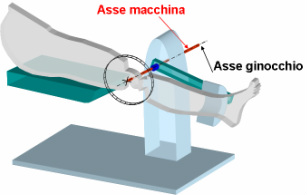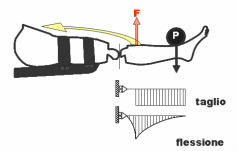rebound
Wanting to determine the causes of such pain, it was initially hypothesized the possible incompatibilities between the knee motion as joint subjects of the exercise and the kinematics of the movable arm of the machine that develops around a fixed center.
|
The leg extension It is a sports equipment for the extensor musculature strengthening of the lower limb. Is like a chair rather high which is laterally connected with a movable arm of load that vertically runs, along the longitudinal axis of the leg and rotates around a fixed center whose axis of rotation must be coaxial with the horizontal axis which transversely passes to the femoral condyles. The movable arm in its distal part is connected to a load P that has to be won in leg extension on the thigh by the contraction of the quadriceps muscle. When extension is complete, the leg is located in line with the thigh, which remains resting on the seat of the equipment while the leg is without any support. |
For a detailed mechanical analysis on the distribution of forces acting in the specific exercise you can then differentiate two situations:
static
dynamic
static
dynamic
For this purpose the leg itself has been compared to a cantilever beam, hinged on a carriage placed on the articular plane of the knee -vertical plane tangent to the point of contact between the tibial plateau and femoral condyles and restrained by an elastic structure ( cruciate ligament) and constructed the diagrams of cutting and flexion (for cutting we mean a force acting on the vertical plane, which has an intensity equal to the applied load in all the points of the beam and for flexion we mean the product loading / arm that is determined in each point of the beam).
|
In static the cutting and flexion diagrams show a precise balance between the loads acting on the beam. In the dynamics, however, the inertia of the moving masses develops stress of "rebound" that discharge on the cruciate ligaments. In the extension, in fact, the kinetic energy acquired by the movable arm tends to continue the overload against gravity. |
|
At full extension, with the maximum contraction of the quadriceps, the point of insertion of the latter on the tibia (tibial tuberosity located at few centimeters of the articular plate) becomes the fulcrum of the system around which the distal part of the leg and foot, dragged by the force of inertia due to motion, continues moving on the vertical plane; to this "rise" is opposed a lowering of the proximal portion (tibia head), which puts traction the posterior cruciate ligament. When the load reaches the top dead point, turns "raising" potential energy, that after returning to weigh on the leg creates a condition of "tilt", by lowering the distal part of the leg and foot to which is opposed the lifting of the proximal portion (tibia head); this impulsive action puts in traction the anterior cruciate ligament. |
|
The alternation of traction on the cruciate ligaments is analogous to a "rebound", which can be highlighted with the abnormal closing of the diagram of flexion and creates a microtraumatic condition which on an healthy knee can be accidentally felt, while on one traumatized even partially knee, may cause particularly adverse effects and pejorative.
At the phenomena of "rebound" has been attributed the cause of the pain complained by some athletes as initially described.


